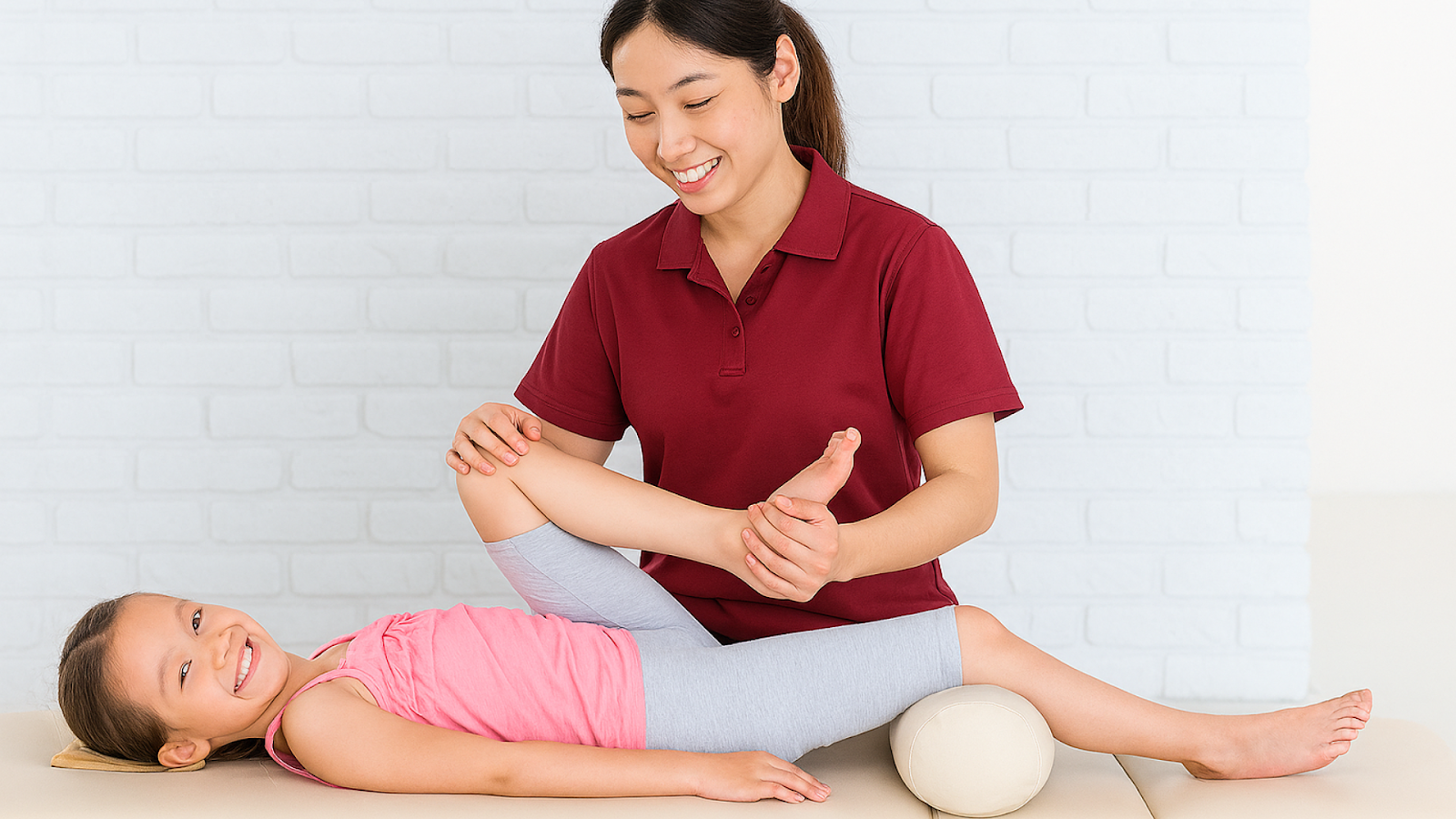“My child’s knee hurts… is that normal?”
It often starts small, a bit of knee pain after PE class. Some limping after football practice. Your child brushes it off, saying, “It’s fine, Mum!” But then the pain keeps coming back—maybe even worse than before.
Sound familiar?
You’re not alone. Many parents in Singapore notice knee pain in their active children and assume it’s just part of growing up. But in many cases, it’s not just a growth spurt—it could be Osgood-Schlatter Disease.
What Happens If You Ignore It?

Left unaddressed, Osgood-Schlatter can worsen over time. Kids may start avoiding sports, limping during daily activities, or developing a noticeable bump under the knee. In more serious cases, they may even face long-term complications, like chronic pain or difficulty kneeling.
And here’s the hard truth: brushing it off as “normal growing pains” might delay recovery and lead to frustration for both you and your child.
Early Recognition and Expert Help

The good news? Osgood-Schlatter is treatable and often manageable with the right care. And the earlier you address it, the faster your child can recover and get back to being active, pain-free, and confident.
Let’s dive into what it is, how to spot it, and what to do next.
What Is Osgood-Schlatter Disease?

Osgood-Schlatter Disease is a common overuse injury affecting the growth plate just below the knee. It happens when the quadriceps (thigh muscles) repeatedly pull on the developing bone at the top of the shin (tibia), causing pain, swelling, and sometimes a bony bump.
It’s most common in:
- Children aged 10–15, especially during growth spurts
- Active kids involved in sports like football, basketball, gymnastics, or dance
- Boys more than girls (although cases in girls are rising!)
What Are the Symptoms of Osgood-Schlatter?

Look out for:
- Pain and tenderness just below the kneecap
- Swelling in that area
- A visible bump or lump on the shin
- Pain that worsens with running, jumping, squatting, or climbing stairs
- Limping after physical activity
Many kids describe it as “a sharp ache” that flares up after exercise but gets better with rest.
Frequently Asked Questions (FAQ)

- What causes Osgood-Schlatter Disease?
- It’s caused by repetitive stress on the tibial growth plate from strong thigh muscles pulling on it, especially during rapid growth.
- How long does it take to heal?
- With rest and proper care, symptoms often improve within a few weeks to months. In some cases, discomfort may persist until the growth plates close (around age 14–16).
- Can I heal Osgood-Schlatter fast?
- There’s no “magic fix,” but early treatment, activity modification, physiotherapy, and good footwear can speed up recovery and reduce pain significantly.
- Does Osgood-Schlatter affect height?
- No, it does not affect growth or final height.
- Can Osgood-Schlatter cause permanent damage?
- If left untreated, it may lead to:
- Ongoing pain into adulthood
- Difficulty kneeling
- A permanent bony lump below the knee
- If left untreated, it may lead to:
- Can kids still play sports with Osgood-Schlatter?
- They can—with modifications. Your physiotherapist may advise reduced training load or alternative exercises to avoid strain during flare-ups.
When Should You See a Physiotherapist or Podiatrist in Singapore?

If your child:
- Has had knee pain for more than 1–2 weeks
- Limp or avoids physical activity
- Has swelling or a bump below the knee
- Complaints of pain after every PE lesson
…it’s time to get checked.
A paediatric physiotherapist can assess movement patterns, recommend personalised exercises, and guide recovery. A podiatrist can identify foot biomechanics that may be contributing to stress on the knees and suggest orthotics if needed.
Story Time: Meet Ethan, 12, Football Enthusiast

Ethan was training twice a week for his school team when his parents noticed him limping after practice. He started skipping stairs and asked to sit out of PE. His mum, concerned, brought him to the Physio & Sole Clinic.
Our paediatric physio diagnosed Ethan with Osgood-Schlatter. Through customised stretches, strength work, and modifying his training load, Ethan was back to light practice in a month and returned to his full game by term break.
Tips for Parents: What You Can Do Now

- Apply ice to the area after the activity
- Ensure your child stretches the quadriceps and hamstrings daily
- Avoid overtraining—take breaks between intense sports
- Choose good supportive shoes
- Encourage open communication about pain
- Don’t force through the pain—listen to the body
- Seek early professional help when needed
Where Can You Get Osgood-Schlatter Treated in Singapore?

At Physio & Sole Clinic, our team of paediatric physiotherapists and podiatrists works together to ensure your child receives comprehensive, evidence-based care. We take time to assess movement, sports habits, and footwear so that recovery is safe, supportive, and stress-free for the whole family.
Don’t Wait — Support Your Child’s Growth, The Right Way
Childhood is meant for running, climbing, and exploring. Let’s make sure knee pain doesn’t get in the way.
Whether your child is limping after CCA or you just want peace of mind, we’re here to help.






